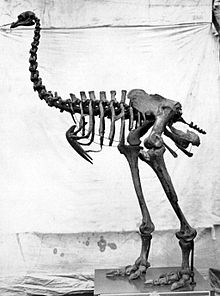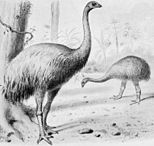Extinct genus of birds
Pachyornis
Temporal range: Late Pleistocene-Holocene |
 |
| P. elephantopus skeleton photographed by Roger Fenton |
Scientific classification  |
| Domain: | Eukaryota |
| Kingdom: | Animalia |
| Phylum: | Chordata |
| Class: | Aves |
| Infraclass: | Palaeognathae |
| Order: | †Dinornithiformes |
| Family: | †Emeidae |
| Genus: | †Pachyornis
(Lydekker, 1891) |
| Species |
- Pachyornis elephantopus Heavy-footed Moa
- Pachyornis australis Crested Moa
- Pachyornis geranoides Mantell's Moa
- Pachyornis new lineage A (undescribed taxon)
- Pachyornis new lineage B (undescribed taxon)
|
Pachyornis is an extinct genus of ratites from New Zealand which belonged to the moa family. Like all ratites it was a member of the order Struthioniformes. The Struthioniformes are flightless birds with a sternum without a keel. They also have a distinctive palate.[1] This genus contains three species,[1] and are part of the Anomalopteryginae or lesser moa subfamily. Pachyornis moa were the stoutest and most heavy-legged genus of the family, the most notable species being Pachyornis elephantopus - the heavy-footed moa. They were generally similar to the eastern moa or the broad-billed moa of the genus Euryapteryx, but differed in having a pointed bill and being more heavyset in general. At least one species (P. australis) is assumed to have had a crest of long feathers on its head.[2] The species became rapidly extinct following human colonization of New Zealand, with the possible exception of P. australis, which may have already been extinct by then - although the most recent moa skeleton ever described is a partial skeleton of this species, radiocarbon dated to between 1396 and 1442. [unreliable source?]
Two new genetic lineages, which may eventually be described as new species, are now known to have existed, one each from New Zealand's North and South Island.[3]
References
- ^ a b Davies, S. J. J. F. (2003). "Moas". In Hutchins, Michael (ed.). Grzimek's Animal Life Encyclopedia. Vol. 8 Birds I Tinamous and Ratites to Hoatzins (2 ed.). Farmington Hills, MI: Gale Group. pp. 95–98. ISBN 0-7876-5784-0.
- ^ Tennyson, Alan; Martinson, Paul (2006-01-01). Extinct Birds of New Zealand. Te Papa Press. ISBN 978-0-909010-21-8.
- ^ Baker, Allan J.; Huynen, Leon J.; Haddrath, Oliver; Millar, Craig D.; Lambert, David M. (2005). "Reconstructing the tempo and mode of evolution in an extinct clade of birds with ancient DNA: The giant moas of New Zealand" (PDF). Proceedings of the National Academy of Sciences. 102 (23): 8257–8262. Bibcode:2005PNAS..102.8257B. doi:10.1073/pnas.0409435102. PMC 1149408. PMID 15928096.
Bibliography
- Lydekker, Richard (2006) [1891]. "Genus Pachyornis". Catalogue of the Fossil Birds in the British Museum (Natural History). London, UK: Adamant Media Corporation. p. 318. ISBN 0-543-95778-0.
- Worthy, Trevor H. (2005). "Rediscovery of the types of Dinornis curtus Owen and Palapteryx geranoides Owen, with a new synonymy (Aves: Dinornithiformes)" (PDF). Tuhinga (16): 33–43. Archived from the original (PDF) on 2011-07-24. Retrieved 2011-02-15.
External links
Wikimedia Commons has media related to Pachyornis.





 Category
Category












